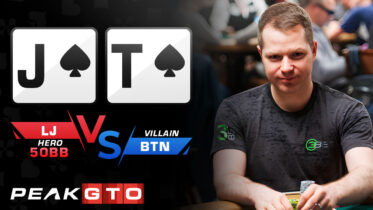Online poker saw a resurgence in 2020. When live poker was not available, players found online cardrooms and started playing poker in the comfort of their own homes. If willing to put in the effort to study, tournament and cash game players alike can make a profit playing online poker despite online games being tougher than live ones. Want to take your online poker game to the next level? This article is certainly a great place to start.
Online Poker Tournaments
Adjusting To Different Stack Sizes In Online Poker Tournaments
Most small-stakes poker players are either oblivious or do not care about the fact that stack sizes are different. They three-bet with just the best hands and do not care what position they are in. Not adjusting poker strategy in accordance with differing stack sizes is a big leak.
At high stack-to-pot ratios, when you are deep stacked a hands value primarily comes from making the nuts, meaning single pair type hands that struggle to get to showdown have a difficult time. Hands like A-5 suited, 9-8 suited and 10-8 suited are way better than hands like K-10 offsuit. Medium pairs and better are good as when they make a set, it usually results in profit. While the majority of pairs and good, suited connectors hold value, small pairs, offsuit big cards, and junky, suited connectors are less valuable as they can potentially run into better hands.
A common scenario you will see in online poker tournaments is a raise with A-K offsuit that is followed by a three-bet and a four-bet. While you can move all-in with A-K offsuit, do you really want to risk 200 big blinds with a hand that is likely behind? The answer is probably no, showing why it is necessary to adjust to a deep stack strategy.
Playing with a shallower stack, the hands that have high value and low value when deep stacked flip flop. With a small stack, hands that have the potential to make top pair go up in value. When you have a stack as low as 15 big blinds, hands like K-10 offsuit suddenly don’t look as bad. If you flop top pair with 15 big blinds, you are thrilled to get your money in.
Hands with good implied odds, while having good odds deep-stacked, go down in value the shallower you get. Even if you pick up a nice draw on the flop, you are still not comfortable getting your money in as you do not have a winning hand yet. Failing to adjust your ranges in accordance with your stack size will result in you lighting your money on fire. By studying the correct Game Theory Optimal (GTO) charts you will know what hands to play at what specific stack sizes.
Playing With A 40 Big Blind Stack: 5 Key Adjustments To Make
Most poker players play reasonably well deep stacked, but as their stacks get shorter they fail to make crucial adjustments.
#1 Tightening up opening ranges and failing to let their range contain more big cards and less suited connectors/small pairs
One mistake I made for a long time that a lot of poker players still make is playing small pairs from every position. The goal of set-mining when you are shallow stacked is a fool’s errand, as even when you hit your set you are vulnerable to being beat by a better one. In early position pocket fours and even pocket fives should be folded when you have a shallow stack.
#2 Tighten up preflop calling ranges
If someone raises preflop and you have yet to act with 9-7 suited, it is not in your best interest to call preflop when you only have 25 big blinds. When you get shallower stacked, hands with implied odds go down in value. You are much better off with big cards that can make top pair as opposed to hands where you may have to risk it all with a draw.
#3 Barrel off against tight players
Facing tighter, more timid players, you should be more willing to barrel off your stack against them as there is a good chance you can successfully bluff them out of the hand. While it may feel scary, waiting around for the perfect hand is an even scarier prospect when short-stacked, be willing to target tight, nitty players who won’t need much convincing to fold.
#4 Do not bluff stubborn players
Facing stubborn players that will be willing to hero call you down with middle pair, bluff less often. Some players will be calling stations and unwilling to give up facing a short-stacked opponent (you can include myself in this group). If you know your opponent is not afraid to call you down, it makes no sense to target them with a bluff.
#5 Respect raises more on later streets
Especially at the smaller stakes, you must give players more credit when they are willing to raise you on the turn and river. The majority of the small stakes population does not bluff nearly enough, which means when someone check-raises you on the river in a $100 tournament, they probably have it. At final tables, raises on later streets should be respected even more as the payout implications often discourage players from risking their stack with a bluff.
Online Tournament Hand Example
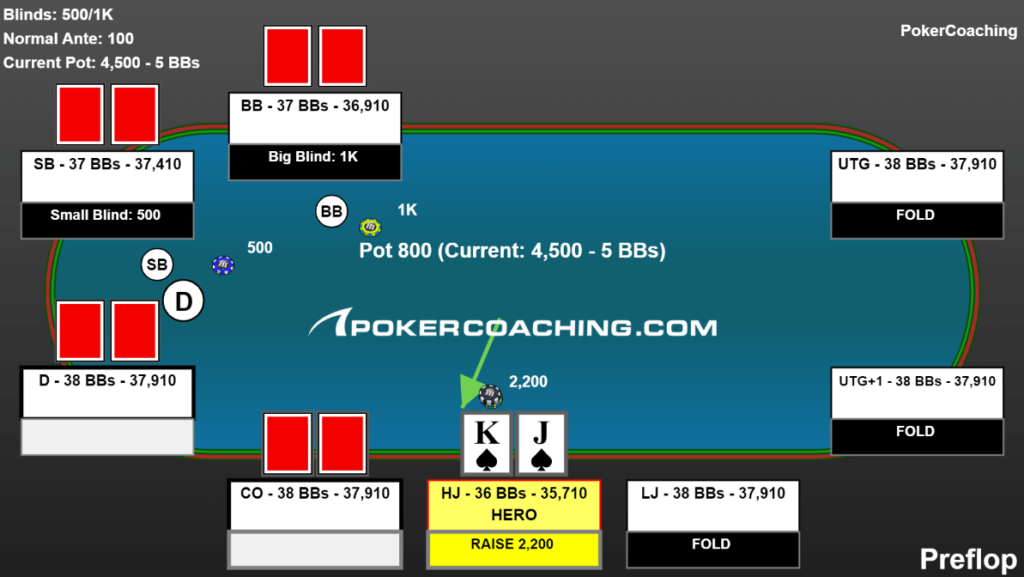
In this hand, you have K♠-J♠ in the hijack and raise it up to 2,200 with a 38,000 stack and the blinds at 500/1,000.
The big blind calls and the flop comes T♠-5♠-2♣, your opponent checks and you make a 2,000 continuation bet, which your opponent calls.
The turn is the 7♦, after your opponent checks, you must think about what your opponent will do incorrectly. If you think your opponent is the type to check-raise you all-in a lot on the turn with a paired ten or seven, you do not want to bet. Even though you have a strong flush draw, if you bet and your opponent forces you all-in, unfortunately, you have to fold. Facing an aggressive opponent, you are far better off checking your high equity hand to see if you can hit your king-high flush on the river.
Now, say you are in the exact same spot on the turn, but instead of an aggressive, battling opponent the big blind is a tight nit. Facing a tight opponent, betting actually makes the most sense as you can get them to fold and in turn win the hand without having to hit your flush.
Your decision on the turn illustrates the importance of paying attention to your opponent’s tendencies and using that knowledge to make the correct decisions. By paying attention even if you aren’t in a hand, you can make profitable plays down the road.
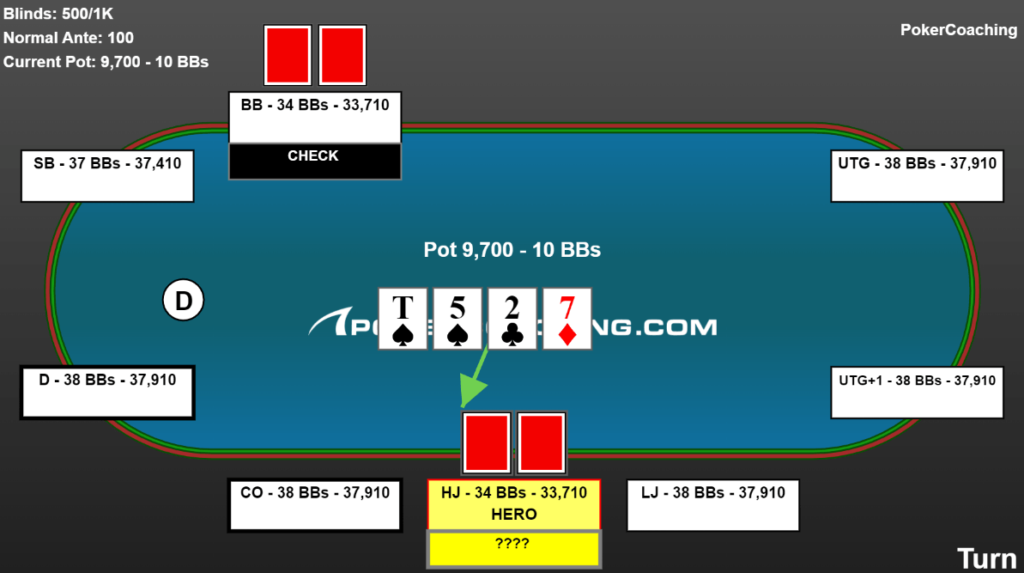
On the turn, you elect to bet 6,000 and your opponent calls. The river card is the Q♦ and your opponent checks.
In this situation, your opponent likely has a pair of tens or worse. Considering your opponent’s range, regardless of their play style you must triple barrel since you already raised preflop and bet two streets. Even if they think you were bluffing on the flop and turn, your bluffing range still consists of a lot of queens.
While you know you must bet, what sizing is correct? If you shove your 29,600 remaining chips into the 22,300 pot, some opponents will see the giant bet and assume it is a bluff due to its size. While those players do exist, other players on the more conservative side will see the large bet size and assume you have a good hand. In general, betting a medium size is the ideal play as a lot of players will refuse to fold a paired ten. While a medium bet size may get called, it is also large enough to work as a bluff, giving you a shot at getting it through while not risking your whole stack.
Play Well with Short Stacks In Online Tournaments
Not to continuously beat up on small stakes players, but another mistake I consistently see them make is only utilizing a push/fold strategy when they are under 20 big blinds. Blindly following a push/fold chart is not the optimal play regardless of what your stack size is.
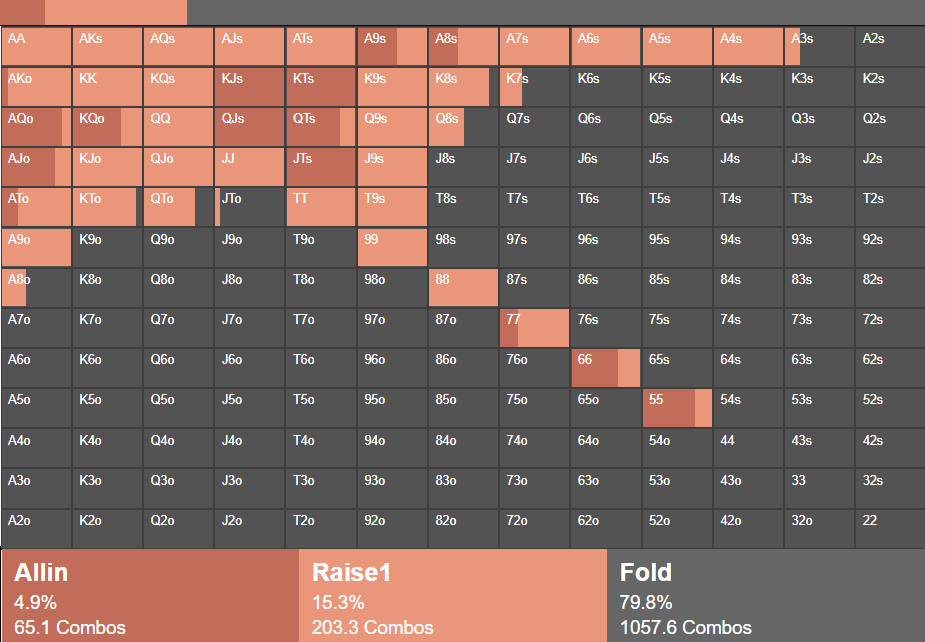
Examining the above chart, you will see plenty of raising hands in the short stack range. From the lojack, about 75% of playable hands are min-raised rather than shoved, with the shoving hands being strong yet marginal hands you don’t mind getting through.
Adjusting and Knowing When To Re-Jam
Consider your short stack strategy when instead of being the first player to raise, you instead must react to an opponent’s raise.

Examining the above chart, you’ll notice that when on the button facing a raise from under the gun (UTG), there are still some hands in your calling range, including aces! Having this calling range allows you to play more hands profitably. By calling and slow playing with aces as a short stack, it allows you to include other, weaker hands in your range like A-8 suited.
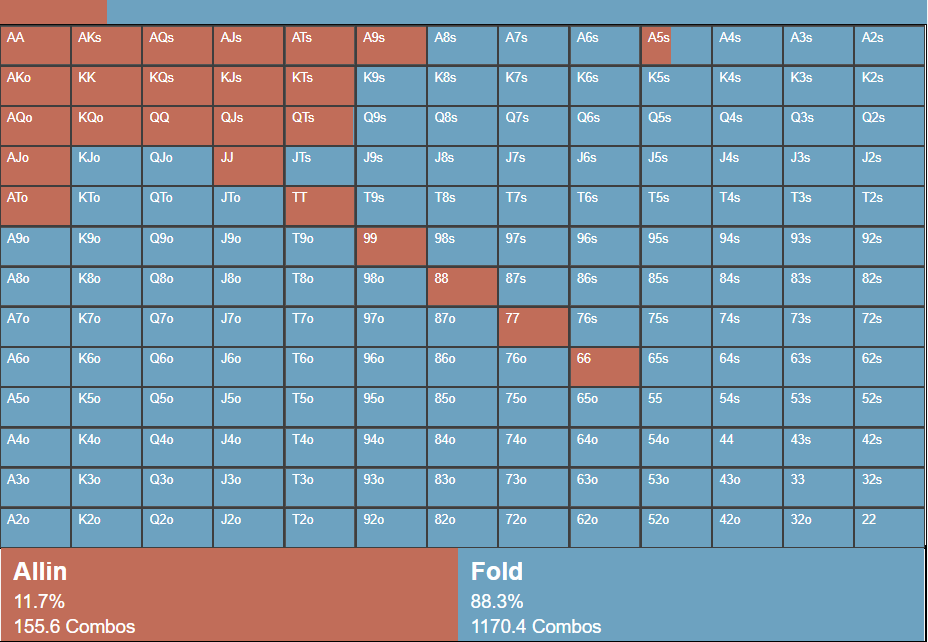
Facing a lojack raise from the cutoff with a short stack, unlike Button vs UTG you have no hands in your calling range. The lack of calling hands is due to having players yet to act, you would much rather move all-in than call and risk having to play the hand multi-way with your dwindling stack.
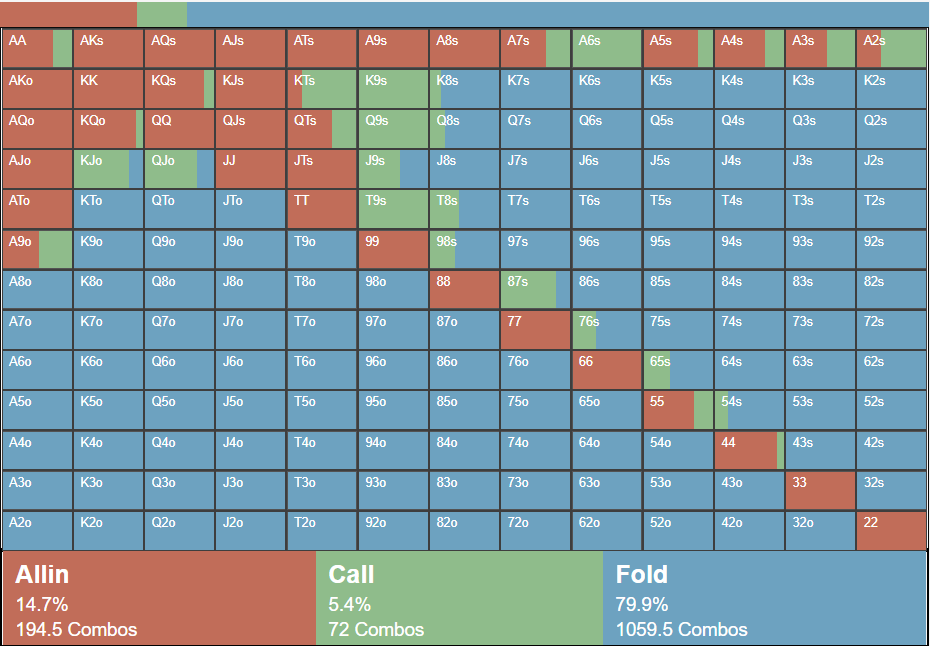
Responding to a lojack raise from the small blind, you maintain a strong calling range and should mix in calls with pocket aces. While you still shove your aces the majority of the time, mixing in calls balances your range and lets you get paid off when you successfully slowplay.
When working to implement GTO charts into your game, it is important not to get overly wrapped up with proper percentages and plays. Some players will overly nitpick when trying to fully implement GTO strategies into their game, but more often than not they just confuse themselves. Use the charts as a reference and implement the general strategies the charts represent, following the implementable charts will leave you well equipped for success.
Online Tournament Hand Example
The UTG+1 players raises to 12,000 out of their 158,000 stack with the blinds at 2,000/5,000. It folds around to you on the button and you look down at A♣-A♥ with 95,000 chips remaining.
If you use a all-in or fold strategy in this spot, you are lighting your money on fire. Referencing the earlier BTN vs UTG chart, calling with aces is the optimal play. While aces will occasionally get outdrawn, the majority of the time you will get most of your stack in by the river and take down the hand.

The flop comes K♠-7♦-2♥ and your opponent bets 15,000. With the dryness of the board, there is no point in raising and scaring your opponent away. You make the call.
The turn is the T♠ and your opponent rips it, offering you their chips on a platter. You make the easy call and they reveal an open-ended straight draw with Q♣-J♣., if you had moved all-in on the flop you would have likely scared your opponent away and missed out on your well-deserved double-up.
Exploit Your Opponents’ Leaks Online
Loose-Passive Players
A common opponent you will face at the small stakes will be one who plays too many hands and plays them passively. These opponents will often call a lot of hands preflop and will only stay in the hand if they flop well. In response, you should value bet these opponents relentlessly, as they will often be holding a marginal hand capable of being folded.
Most of the time, loose, passive players will be just fine calling you down with a wide range of hands, but what should you do if they execute a check/raise? The answer is easy: fold! If a normally passive player all of a sudden is check-raising you, they are likely strong and have you beat. There is no sense trying to outplay these opponents when check-raised, if they are clearly going to show you they have a better hand, save your chips and let them have it, because they are not bluffing.
The final exploit for loose, passive players is bluffing them on later streets when you believe them to be holding a marginal hand they are capable of folding. When the board dynamic changes significantly on the river, it is a great spot to execute a bluff. Loose, passive players play very straightforwardly, if they raise you and are willing to add money to the pot you should fold (because they don’t bluff), and if they call every hand squeeze value from them with top pair and go for bluffs on the river, it really is that simple!
Loose-Aggressive Players
Much like loose-passive players, loose-aggressive players (LAGs) also play too many hands, but as their title suggests they play them aggressively. While these opponents aren’t all that common at the low stakes, when they are present they often do quite well as their well-placed aggression often dominates loose-passive fields.
Facing LAGs, it is important to realize that when they apply pressure they are usually doing so with a marginal hand. If you are willing to counter their aggression with aggression of your own, you have an opportunity to get them to fold, as they will usually assume you are strong by not backing down.
If you remember the tendency of LAGs to bluff marginal hands, you have a great opportunity to siphon their chips if you are willing to not back down to their bluffs. When you have a decently strong hand and they continue to barrel into you, call them down and let them bluff all their chips away. A successful exploitative strategy is based in seeing what your opponents do and adjusting, if you know a LAG will punt it off with air, call down with your two pair and scoop the pot.
When looking for spots to bluff LAGs, the best ones are when the board is scary and well coordinated. When straight and flush draws complete on the river, LAGS will usually assume you have what you are representing and fold to big bets. When LAGs play overly aggressive, often the best course of action is to counter their aggression with better-placed aggression of your own.
Tight-Passive Players
Tight-passive opponents are commonly referred to by their less flattering title: nits. Nits are common at the low stakes and are the easiest opponents to exploit. By over-folding, nits allow you to steal their blinds by playing an appropriately aggressive strategy with the right hands. While nits allow to you steal their blinds and easily bluff them out of hands, they also make it extremely clear when they have a good hand and will let you know when you should fold. Unless you have a remarkably strong hand or are being offered the right implied odds, fold to tight-passive opponents when they continue betting into you.
Tight-Aggressive Players
Tight-Aggressive players (TAGs) will be the most competent players you will face at the small/medium stakes, but they can still be exploited if you are well studied.
A common trait amongst TAGs is their inability to fold hands they perceive as strong. TAGs will go card dead for hours, finally get dealt a hand like pocket jacks, and will refuse to fold them as they have been waiting forever for a good hand. Such a mindset is disastrous at the poker table, if the flop comes A-K-7 monotone and they lack the right suit, they should be folding!
Facing tight-aggressive opponents that will overvalue their premium hands, play hands that have great implied odds. Especially at the beginning of tournaments when you are deep stacked, try to see a lot of flops with hands that have good odds to beat aces when given the right board. Suited connectors are great candidates for this and can be used to crack aces facing TAGs that are unwilling to fold them.
Just as critical as knowing what hands to play against TAGs is knowing which hands to fold. The majority of the time, hands like top pair should be folded when you do not have the top kicker.
For example: let’s say you have K-J and the board comes K-10-6. Your TAG opponent (who raised preflop) bet the flop, bet the turn, and is continuing to bet on the river. Despite having top pair, you should fold on the river, and sometimes it may even make sense to fold on the turn if you know your opponent is going to keep firing! While it may sound strange, you can crush TAG opponents by making exploitative folds and refusing to provide them chips when behind.
Just like tight-passive opponents, TAGs are prime candidates to have their blinds stolen, as any tight opponent will not maintain a range wide enough to prevent you from stealing them.
Online Tournament Hand Example
In this tournament hand, it folds around to you in the hijack and you have Q♦-10♦ playing deep stacked. You make a standard 1,500 raise and both the splashy button and bad LAG in the big blind call.
Following the flop, the big blind checks and action is on you with top pair. You bet 2,100, and only the big blind calls.
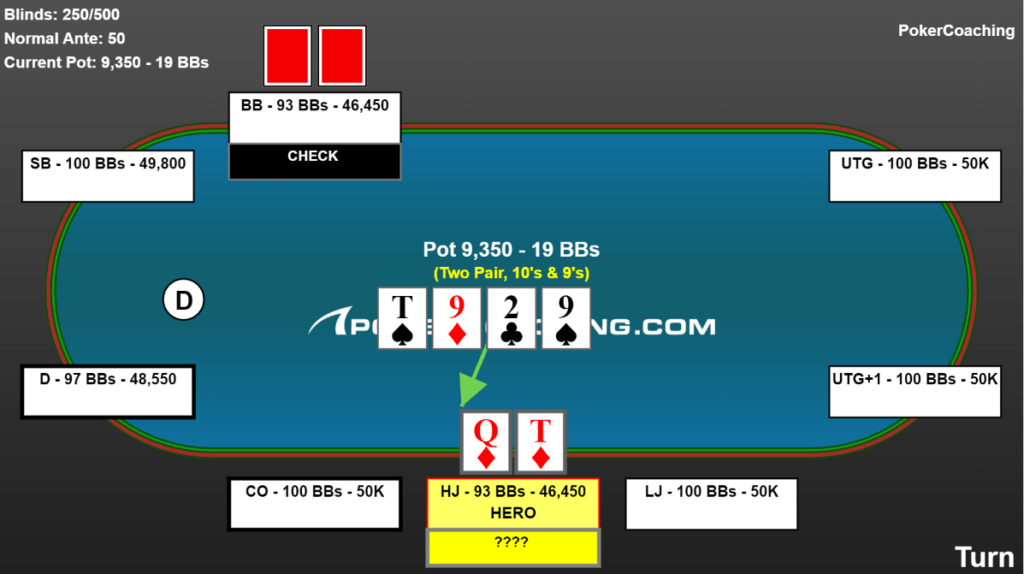
Following the board pairing on the turn, your opponent checks.
A lot of players make the mistake of continuing to bet on this turn, but considering the range of you and your opponent, they have a lot more nines than you. Even if the big blind doesn’t have a nine, if they are a LAG they are more than capable of bluffing you on what may very well be the better hand.
Checking is the best play in this spot, by checking not only do you avoid getting check-raised, but you can effectively bluff-catch if your LAG opponent tries to steal the pot on the river.
Implementable Exploits For Online Poker Tournaments
Size Up With Premium Hands On Dynamic Boards
A dynamic board is when the community cards in a Texas Hold’em hand have a high likelihood of changing dramatically on the turn or the river. Dynamic boards usually have a lot of straight draws and flush draws present. Especially at the smaller stakes, players do not thinly check-raise dynamic boards enough, incentivizing you to make big bets for value when you have strong hands. If you don’t have to worry about your opponents bluffing you, you can go for value more often with your premium hands.
Online Tournament Hand Example
You are on the button in a small stakes online tournament with 20,000 and the blinds at 250/500. It folds around to you on the button and you raise 1,100 holding K♠-K♣. Only the big blind calls.
The flop is 9♥-7♥-2♣ and the big blind checks. Believe it or not, the correct GTO play is to check back 30% of the time, but considering the flop connects well with the big blind’s range, betting large is the preferred play. If you know your opponent is not going to check-raise or bet often enough on the turn or river, bet large with your premium hands to try and grow the pot. You bet 2,500 and your opponent calls.
The turn is the 2♠ and your opponent checks. Considering your opponent’s flop calling range, it is mostly made up of paired nines, sevens, and draws that have still yet to get there. Do not be scared of the board pairing, as your opponent lacks twos in their range. Contemplating a bet size, it is best to bet big but not too big. If you bet too large, you will tip off your opponent that you will not fold to an all-in. Luring your opponent into adding money to the pot requires convincing them they have some fold equity even if they call a turn bet. Betting two-thirds as opposed to full pot keeps them involved in the hand and sets up the right stack-to-pot-ratio (SPR) for a river shove.
You bet 5,000 and your opponent calls. The river is the Q♠ and your opponent checks.
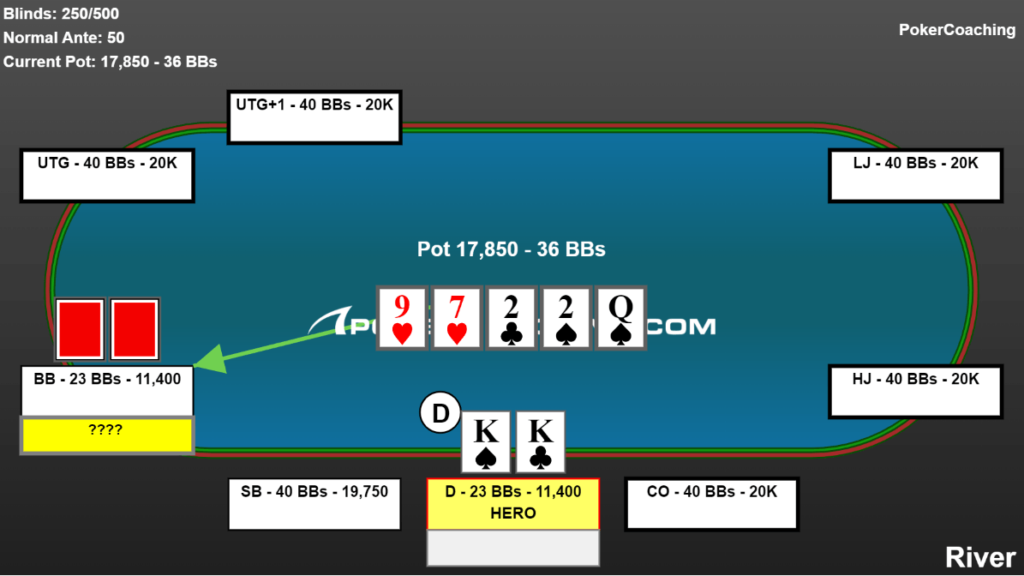
With the right SPR on the river, this is an easy all-in. You move all-in and your opponent folds, despite the outcome on the river you still scooped a sizeable pot. Notice how your bet sizes provided you will a substantial pot, by betting large on the flop you naturally could bet bigger on the turn, helping grow the pot. Adding equity in this way allows you to chip up consistently, a requirement for making deep runs in online tournaments.
Online Tournament Hand Example
You are playing a low-stakes, online tournament with 40,000 and the blinds at 500/1,000. It folds around to you in the cutoff and you raise 2,100 holding A♠-K♣. Only the big blind calls, the flop comes A♦-8♣-5♠, and the big blind checks. Although 4,500 may seem like a big bet, it is the ideal bet seeing as the board can change on the turn. It may be tempting to bet smaller to incentivize weaker hands into calling, but any hand that will not call a medium-sized bet on this flop will not call a small one either. You bet 4,500 and your opponent calls.
The turn is the 2♦, the big blind checks and you bet again this time for 7,000. Even though we bet slightly less than half pot, if the villain calls the 7,000 bet the SPR will be enough to make a river shove with what is likely the best hand. Your opponent calls the 7,000 bet.
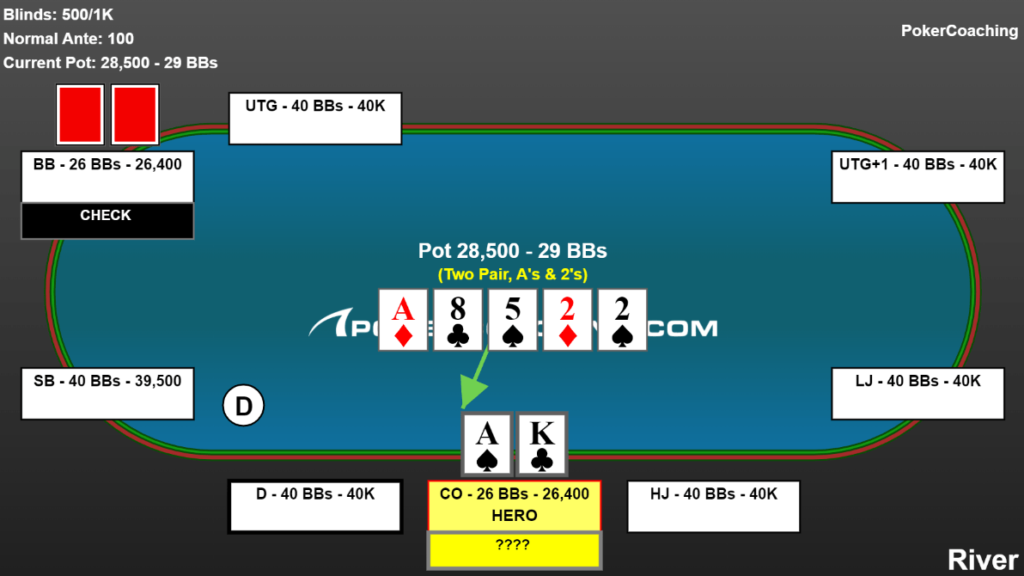
The river is the 2♠, after your opponent checks you have an easy all-in with 28,700 in the pot and 26,400 remaining in your stack. Your opponent s folds, again showing how betting bigger with your premium hands rewards you with bigger pots.
Check-Raise The Flop Relentlessly
Weak and even some strong poker players fail to defend check-raises enough at the smaller stakes. If your opponents don’t defend against check-raises, you are incentivized to check-raise more and exploit them! While this can certainly be a challenge to implement, if your nitty opponent all of a sudden calls your check-raise, it is worth considering how strong their range is.
Online Tournament Hand Example
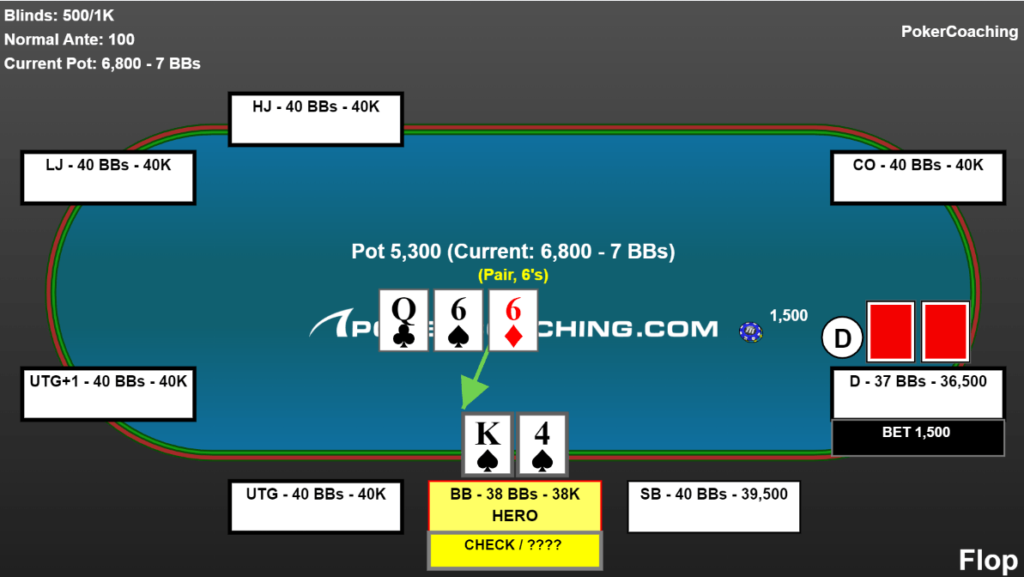
You are playing in a small stakes, online poker tournament with 40,000 and the blinds at 500/1,000. It folds around to the button who min-raises 2,000, after the small blind folds action is on you holding K♠-4♠.
You make the call, the flop comes Q♣-6♠-6♦ and your opponent bets 1,500 following your check. With the range advantage you have and how poorly K♠-4♠ plays as a call out of position, this is a spot where you should check-raise. With the equity you have with a king and runner-runner flush draw, you don’t mind if your opponent makes the call as you can still improve.
Junky hands that have the potential to improve on the turn check-raise frequently facing a small bet from the button. Opponents at the smaller stakes will not defend nearly enough, providing you a great spot to exploit and steal pots frequently. If your opponents will not defend enough, check-raise wide and punish them for over-folding.
Bet Thinly For Value, Especially Out Of Position
Too often players elect to check every marginal hand they have out of position. Even though these hands aren’t premium, a lot of the time you will have the best hand, and won’t have to worry about opponents raising you as they also have marginal hands. Checking out of position gives your opponents the chance to bluff and keeps you from getting raised, but if neither outcome is likely to happen you are incentivized to bet thinly for value.
Online Tournament Hand Example
You are playing in a small stakes, online tournament with 40,000 chips and the blinds at 500/1,000. It folds around to the button who raises 2,000, you call from the big blind holding K♥-10♣.
The flop comes J♠-10♦-2♣, you check and your opponent bets 1,500 which you call.
The turn is the 6♥ and it goes check-check. Following the 3♠ on the river what is the best play for you to make?
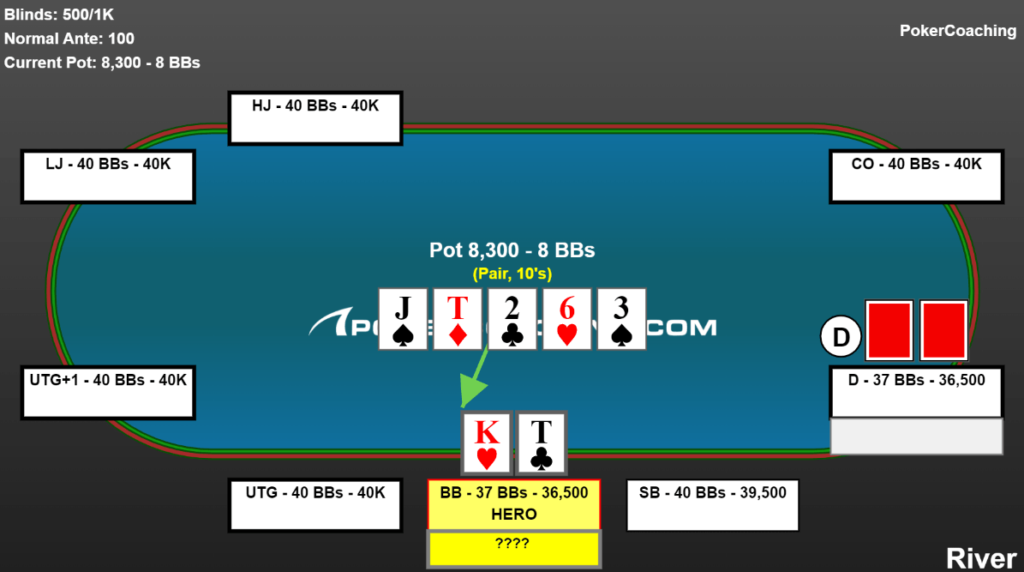
After the turn goes check-check, it is safe to assume you have the best hand almost every time. Most players playing from the button would continue betting the turn if they had the jack, by checking it is highly unlikely they can beat your paired ten. There will be some capable opponents who will check the turn with a paired jack and call you down when you bet the river for value, but the majority of the time they will either fold or call you with worse. With either result, it ends with you scooping the pot.
You bet 5,000 and your opponent finds the call with A♥-6♣. Being brave enough to bet for value rewarded you with some nice additional equity.
Play Aggressively Preflop
Playing aggressively preflop allows you to steal more pots without going to showdown. By stealing small pots consistently throughout the course of a tournament, you will continue to chip up and maintain a playable stack. Growing your stack is a requirement for cashing and winning poker tournaments, making it critical you make moves that will help you acquire chips. A lot of recreational players maintain a “fit or fold” strategy and wait for the nuts to put chips into the pot, but such a strategy only results in their stack dwindling over time.
Having Bluffs In Your Three-Betting Range
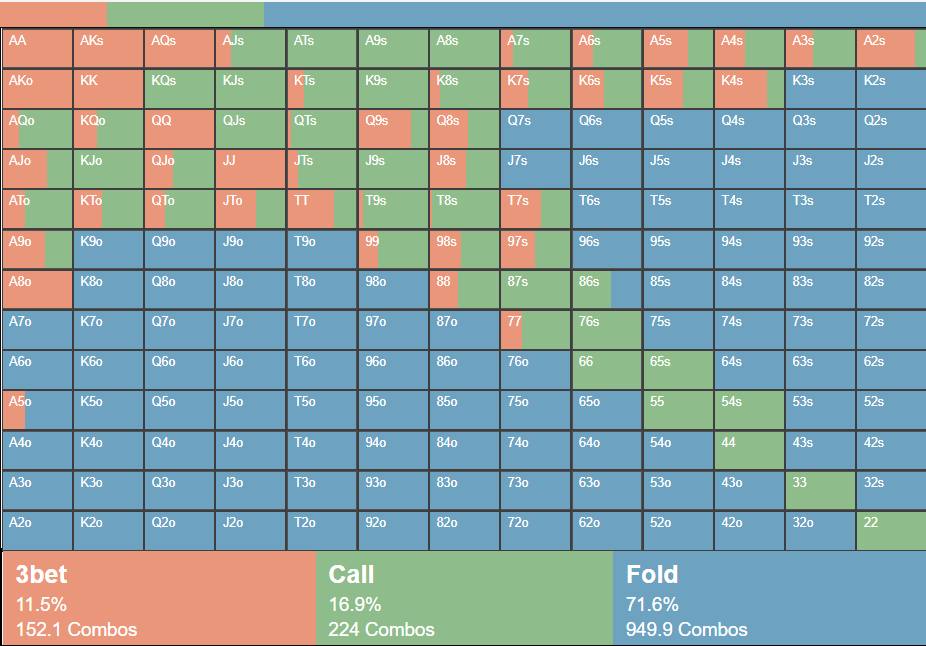
When you are out of position, it is important you use a different selection of hands to three-bet with as opposed to in position. Examine the hands you three-bet bluff with playing from the button facing a cutoff raise.
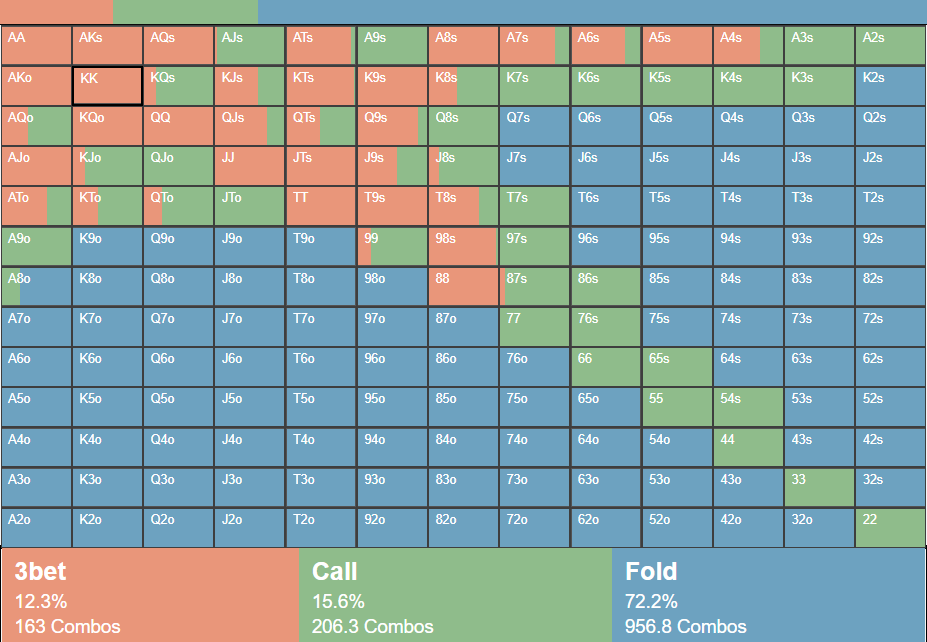
Now, look over the hands you three-bet bluff facing a cutoff raise from the small blind. When three-bet bluffing from the button, you want to bluff with hands that are decent, but not quite strong enough to call with.
Hands like A-8 offsuit and K-4 suited can potentially play well post-flop, but function much better when you have the added advantage of having raised preflop.
Three-betting preflop maintains a strong image and gives you the ability to bluff if that becomes your only path to victory later in the hand.
Looking over the hands you three-bet bluff with from the small blind facing a cutoff raise, you will notice that the hands you three-bet bluff are much stronger than hands from the button. With the advantage being in position provides them, cutoff opponents will call your small blind three-bets more often, incentivizing you to three-bet with stronger hands. While three-bet bluffing with much stronger hands, you should also be calling with stronger hands as well.
Play Aggressively With A Short Stack
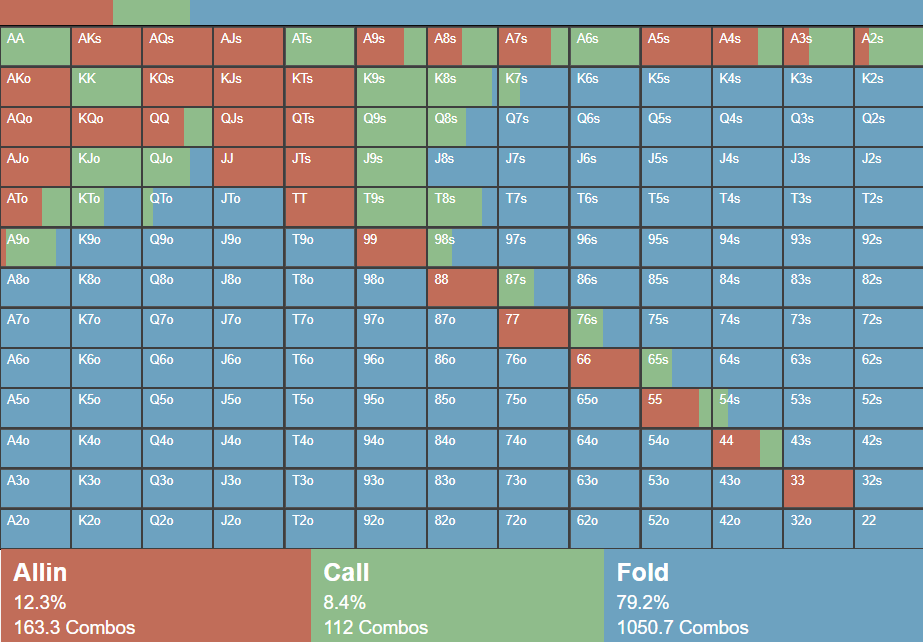
Examining the above chart, you will see that as your stack gets shorter, you should be three-bet shoving all-in with an assortment of hands. From the button facing a raise from the cutoff, with 20 big blinds you will notice that you should be shoving with almost all of your pocket pairs. A lot of poker players make the mistake of calling with pocket pairs with aspirations of flopping a set, but you would much rather raise all-in as the cutoff will have plenty of unpaired hands in their range you will be ahead of.
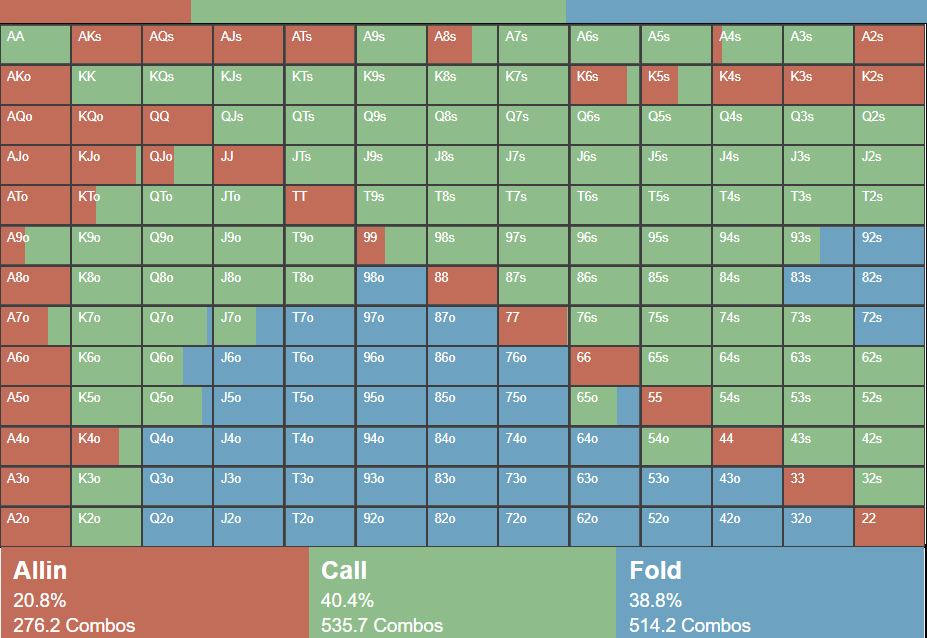
Facing a button raise from the big blind with a 12 big blind stack, not only do you shove with even more hands compared to the previous spot, but you also have a wider calling range as well. Especially if the button player entered the hand first with a min-raise, you can call with a wider range as you are already financially invested playing from the big blind. By contributing just one more big blind, you get to assess your equity on the flop and can put the rest of your chips in the middle when you nail the board.
Don’t Overplay Marginal Hands In Online Poker Tournaments
By far the biggest mistake made by small stakes players is overplaying and overvaluing marginal hands. When reviewing hands from my students, almost all the problems they face at the poker table stem from poor hand selection.
When holding a marginal-made hand, you want to control the pot and play medium pots as opposed to gigantic ones. The bigger the pot, the better the hands your opponents will flip over at showdown, keeping the pot small leads to smaller bet sizes that reflect the value of your marginal-made hand.
Often players at the small stakes struggle to get away from hands like top pair and refuse to fold them even when a plethora of draws get there by the turn and river. To be a profitable poker player, you must realize that sometimes your opponents are going to “get there”, which means having to make tough folds from time to time.
Online Tournament Hand Example
With 40 big blinds effective, it folds around to you in the cutoff and you raise 2.2 big blinds holding J♠-10♠. Only the big blind calls, making it head’s-up.
On the flop (K♣-J♥-6♥), the big blind checks and you make a standard, small continuation bet which your opponent calls.
Following the 7♣ on the turn, your opponent checks. Although you likely have the best hands in this spot, you should check rather than bet. A lot of players would bet in this spot wanting to charge the draws and continue representing strength, but those are not good enough reasons to bet. Recognize that if you bet and get called, you are likely facing a whole lot of kings or a whole lot of high equity draws that will call every time. If only worse hands will fold and only better/higher value hands will call, why bet at all if it is not a profitable play? Even if you had top pair with a king, if you had a bad kicker your hand is marginal and plays a lot better checking and calling off reasonable bets from your opponent on the river.
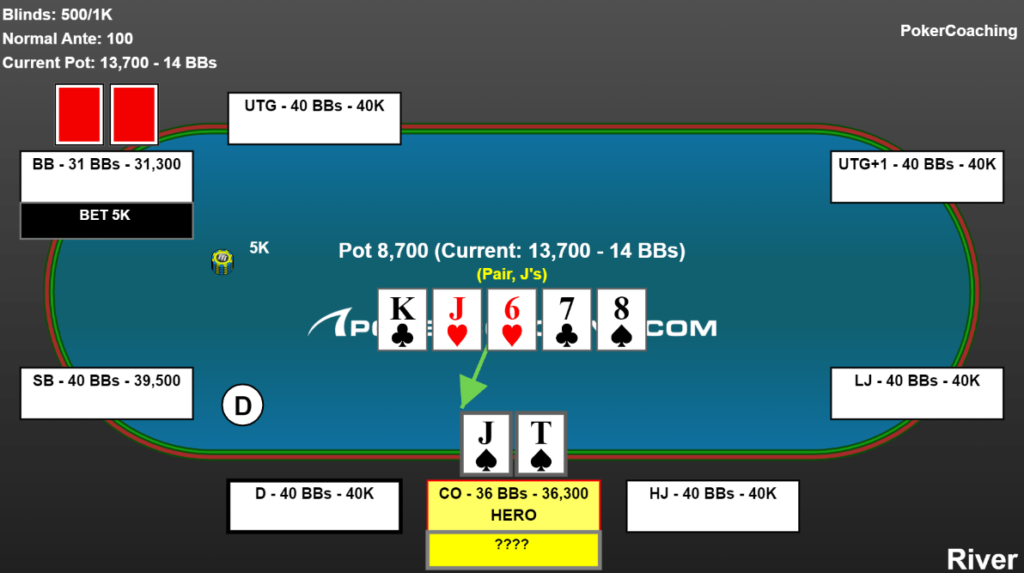
On the river, your opponent leads out for a large bet for over half the pot. Despite only having second pair, this is an easy call! Citing our thought process on the turn, you checked the turn so you could call off on the river. Especially when a lot of draws in your opponent’s range miss, you are incentivized to call on the river because they very well could be bluffing to steal the pot.
While you will sometimes lose the hand, if you have the necessary equity you must be willing to call off with marginal hands on the river.
Over-Fold In Online Tournaments (Especially On The River)
In small stakes tournaments, whether online or live, most of the player population does not bluff enough on the river. Most of the time, when small stakes players bet on the river they are doing it for value with a strong range. If you can recognize this tendency in your opponents, you can adjust and properly exploit them by folding more.
Online Tournament Hand Example
You have 70 big blinds on the button, the lojack min-raises two big blinds and it folds around to you holding K♠-Q♥. You call, and the small blind and big blind call as well.
You flop three of a kind, both blinds check and the lojack bets 5,000. With your strength and your opponent’s willingness to add substantial value to the pot, call and keep them around to add more money to the pot on later streets.
You call and both blinds fold.
On the turn, your opponent slows down and checks. Although it would likely have been better to bet small for value, you check it back.
Following the blank card on the river, your opponent leads out for 7,500. Holding an incredibly strong three of a kind, you raise 22,500, but then your opponent does the unthinkable and jams.

Some players will cite their check on the turn and assume their opponents think they are bluffing since they appeared weak prior to the river, but that is flawed logic. At the small and medium stakes, unless your opponent is a maniac they are either going to have A-Q or a better hand. Even though you have trips, your hand is an easy fold. Whenever it goes bet, raise, then re-raise on the river, your opponent is never bluffing and is not making this play with worse hands.
Online Cash Games
Playing online cash games in high volume is a great way to become a strong poker player. Online cash games are usually tougher than live cash games, and the speed in which hands occur online allows you to see more hands within a smaller window of time. Seeing a high volume of difficult hands on a regular basis provides a wealth of experience that can be used to improve quickly.
Online cash games can be a great source of not just experience but profit, but you must be fundamentally sound as they are competitive and taxing for those not committed.
If you want to beat small stakes cash games for a small amount, it really isn’t that hard even in 2022. If you follow the old school poker strategy of playing tight, being patient, not bluffing, and stealing small pots, you will make a small profit over time. However, that will be the furthest you go on the felt, unable to successfully win big money due to having such a linear strategy.
To be the best equipped for max profits in online cash games, remember the following equation:
Solid Fundamentals + Exploits = Big Cash Game Winners
The Fundamentals Of Online Cash Games
Raise Size Preflop
One of the most important things to have as a successful cash game player is a strong preflop strategy. Raise between 2.5 and 3.5 big blinds, and be sure to never open limp as that will produce a leak in your game. A lot of recreational cash game players utilize funky bet sizes every time they raise preflop, do not model this strategy by maintaining a standard raise size.
Three-Betting Preflop
When facing a preflop raise, elect to three-bet rather than call unless you are on the button or big blind. Not only does three-betting put you in a better position to win the hand, but ir can also prevent the hand from reaching the flop. If you can scoop the pot before the flop, you don’t have to pay the dreaded rake!
Play Tight-Aggressive (TAG) Strategies
Although cash games have a tendency to draw loose-splashy players, maintaining a tight-aggressive strategy will better serve you at the poker table. Anytime you are playing in a game with a rake, you are better served contributing chips towards premium hands as some of that money is guaranteed to not return to you. While playing a TAG strategy may not lead to much excitement, it will be the most profitable for you in the long run.
Raising With The Right Range
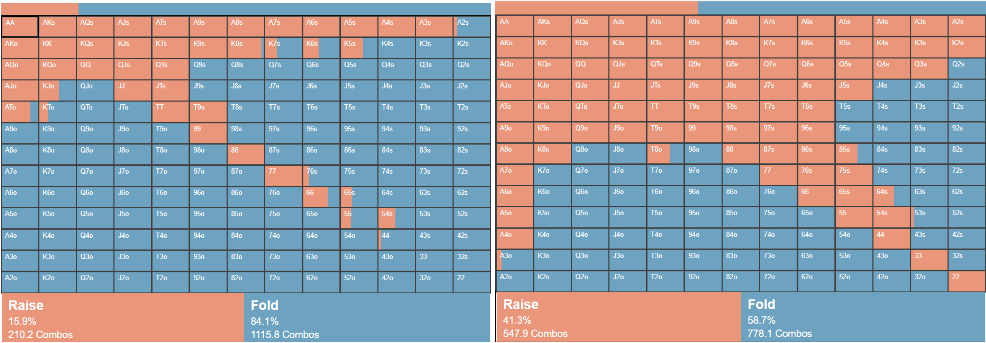
Above you will see two charts, while they both represent the proper Game Theory Optimal (GTO) ranges for raising-first-in (RFI), one represents RFI from the lojack and the other the button.
Notice how much tighter of a range the lojack raises with than the button. While these are good base ranges to maintain, if you are at a weaker table you can broaden them slightly as bad players will three-bet you less often.
Facing A Raise
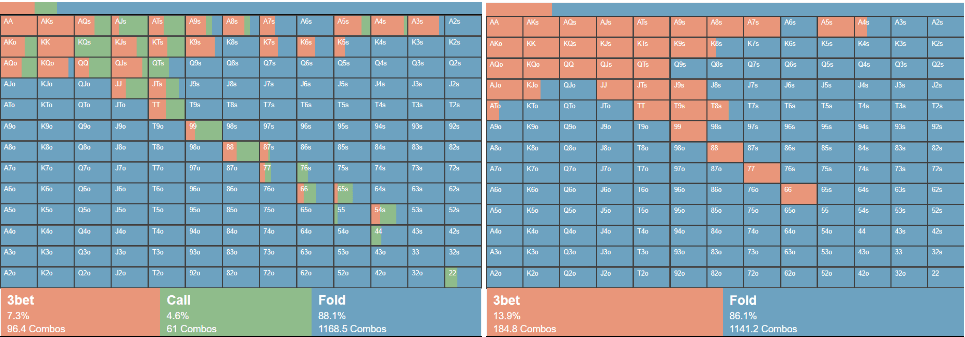
Rather than flatting to raises preflop, you are far better off three-betting with the proper GTO ranges than calling to “see more flops”.
Examining the above three-betting charts, you may be surprised by some of the hands you fold from the cutoff facing a lojack raise. It may feel painful in the moment, but ace-jack offsuit or a low pocket pair should be folded when you are in this spot.
While you do have some calling hands within your middle position versus middle position (MP) three-betting range, they are big card hands that have the potential to flop well, like king-jack suited. While you can have some calling hands facing a lojack raise from the cutoff, you practically have zero calling hands when facing a button raise from the small blind. Accounting for the rake and the fact you will always be out of position, you should only be three-betting any playable hands in your range.
Two Postflop Tips For Online Cash Games
Give Up When You Know You Are Beat
Although it may hurt sometimes, often what sets good poker players apart from the general player pool is their ability to make folds. Most players are too stubborn to give up, especially after putting chips in the pot, but knowing when to give up saves you money.
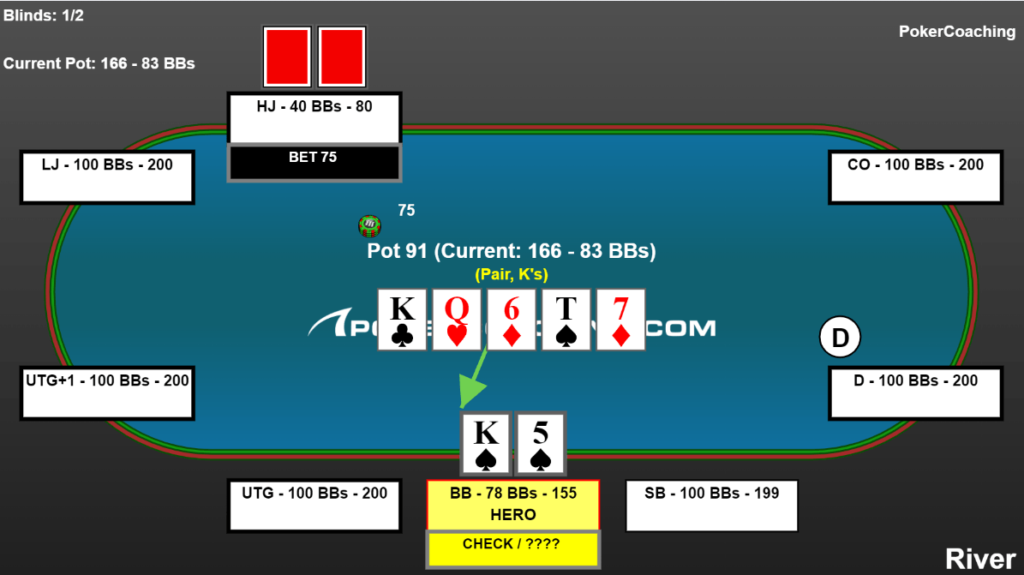
In a $1/$2 cash game, you are on the big blind sitting with a stack of $200. The hijack raises to $10, and it folds around to you holding K♠-5♠. You make the call.
The flop comes K♣-Q♥-6♦, you check and call the hijacks $10 continuation bet. The turn is the 10♠, you check, and your opponent bets again, this time for $25. You call the turn bet, the river is the 7♦, you check and the hijack bets $75. Although you have top pair, you must fold.
At the small stakes, the average player does not bluff enough, especially in big pots. If an opponent is willing to triple barrel in this manner, your top pair-weak kicker is not worth the $75. Taking a moment to consider what your opponent may have that you beat will save you money. Do you think your opponent plays this way from the hijack with K-4? Likely not, making a tight fold the proper play.
Don’t Be Afraid To Go For Value
In this hand, you are playing in a $2/$5 cash game with $500 in front of you. Following a $15 raise from the hijack, it folds to you on the button holding A♠-A♥. You three-bet $50 and the hijack calls.
The flop comes K♣-J♣-7♥, your opponent checks and you bet $27, which they call. The turn is the 9♣ and your opponent checks again, what would you want to do in this spot?
Although you still have the best pair possible, your opponent could easily have improved to two pair, a straight, or a flush. When a card that’s really bad for you comes on the turn, it is a good spot to check, even with your aces.
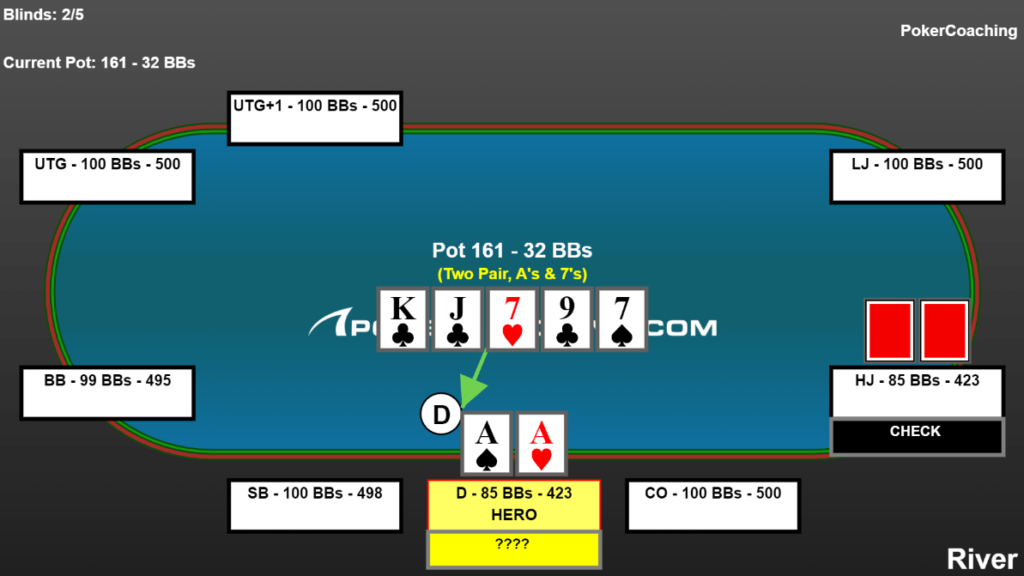
Although it was in your best interest to check the turn, when the 7♠ comes on the river and your opponent checks again, it is time to go for value. At these stakes, if an opponent had hit a straight or flush on the turn/river, there is no way they would check two streets and not go for value. Even if they had a two pair hand like king-jack, the seven on the river could have given you a better two pair.
When considering how much to bet for value, consider the likely hands in your opponent’s range that you can target. In this spot, you could get your opponent to call you with a pair of kings, but how much should you bet? Although there is merit in betting small, in general, it is recommended to go for the bigger size. At the low stakes, players will often find calls with a wide assortment of hands. Betting $100 into the $160 pot is a decent bet size that can convince a hand like a pair of kings to stick around.
Do not be afraid to go for value, when opponents seem content in checking it down you should go for value, because you are likely ahead!
Two Useful Online Cash Game Exploits
Use Overbets To Your Advantage
In a $2/$5 cash game, it folds around to you in the cutoff with a $500 stack. You raise $15 holding K♠-Q♣, and only the big blind calls. The flop comes K♥-T♥-6♦, the big blind checks and then calls your $20 continuation bet.
The turn is the 7♦, not the scariest card, but certainly one that makes the board more coordinated. Holding a decently strong hand on incredibly coordinated boards, the GTO strategy recommends making a chunky overbet for protection.
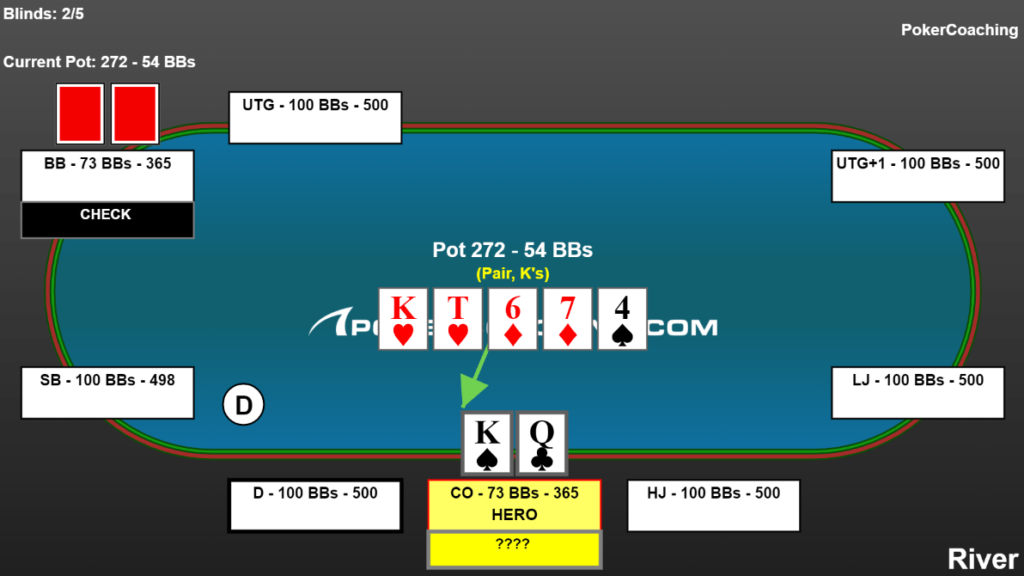
You bet $100, and your opponent calls. The river is the 4♠, and the big blind checks again. Despite having already made an oversized overbet on the turn, the river is another quality spot to make an overbet, this time for all of your stack. Almost all of the draws in your opponent’s range bricked the river, and with your bet sizing on the turn you have made the pot large enough that the SPR warrants a shove. Opponents in $2/$5 will find wide calls when they are not disciplined enough to fold their busted draws, use overbets to your advantage to draw full value from them.
Stop Slow Playing Big Hands
Too often players at the low stakes try to get fancy by slow playing big hands. Slow playing premium hands only decreases the amount of money you win in the long run!
You are in a $1/$2 cash game with $200 on the big blind, the lojack raises $8 and you call with pocket fives. The flop comes Q♥-J♥-5♦, you check and your opponent makes a $15 continuation bet.
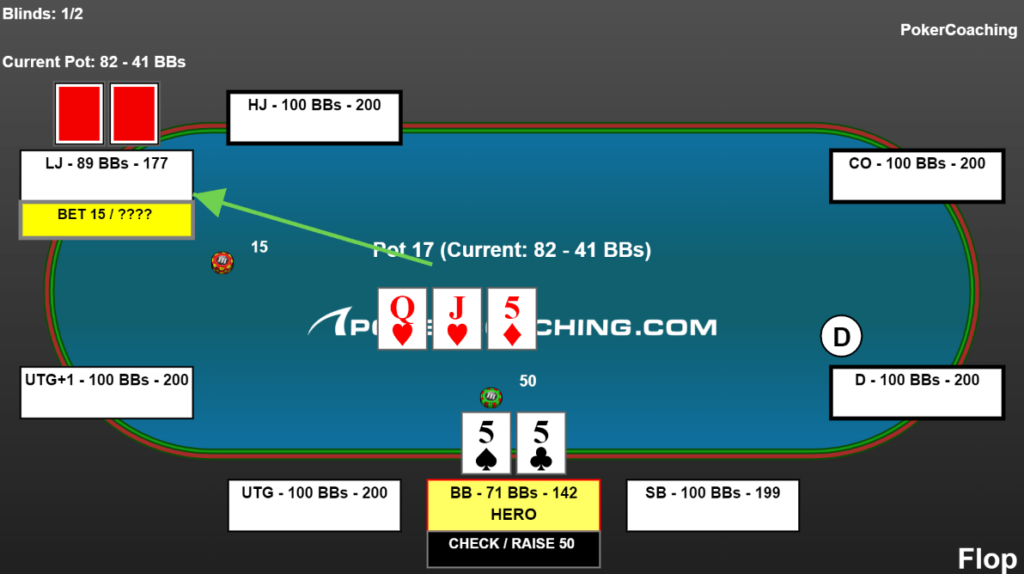
A lot of players will simply call hoping their opponent will be willing to add more money to the pot on the turn, but with how coordinated the board is and considering your opponent’s range, you are better off raising with your set. While you may induce a fold, any hands that fold would not have bet the turn or river either.
Your opponent jams on you, while you may be beat, this is an easy call as there are plenty of hands in your opponent’s range you beat (in this hand, he had aces with no heart).
Play Aggressively Preflop
Playing aggressively and taking advantage of your opponent’s preflop mistakes can help you steal pots in online cash games. Especially at the smaller stakes, recreational cash game players will call a lot preflop, producing a huge leak in their game. Due to the rake of cash games, you want to contribute to a pot where there is value, usually with hands worth raising. Not only would you want to raise with these hands anyway, but if everyone folds to your preflop raise, you collect the pot without paying the rake.
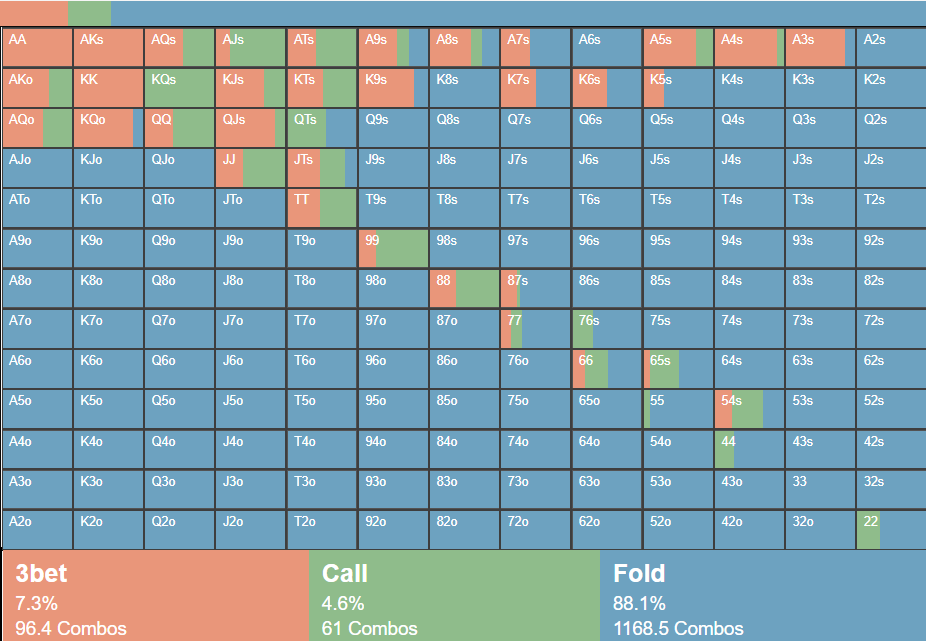
Facing a raise from the lojack in the cutoff, you do no calling and raise a condensed portion of your range. If you are going to play at all, you would only want to do so raising with your best hands.
When three-betting preflop, you will almost always have no calling range. The only time you will have a calling range preflop is when you play from the button. Most cash games you play online will be 6-handed, if you find a nine-handed game you can make some calls from early position after UTG raises, but for the most part the only calling you will do is from the button.
Stop Defending Your Big Blind So Often
If you regularly play tournaments online and are looking to cross over into cash, it is important you know what adjustments you should make. While you are incentivized to defend the big blind often in tournaments, due to the rake you want to do the opposite in cash games. When deep stacked, your equity realization out of position is incredibly poor, making it critical you maintain a proper range.
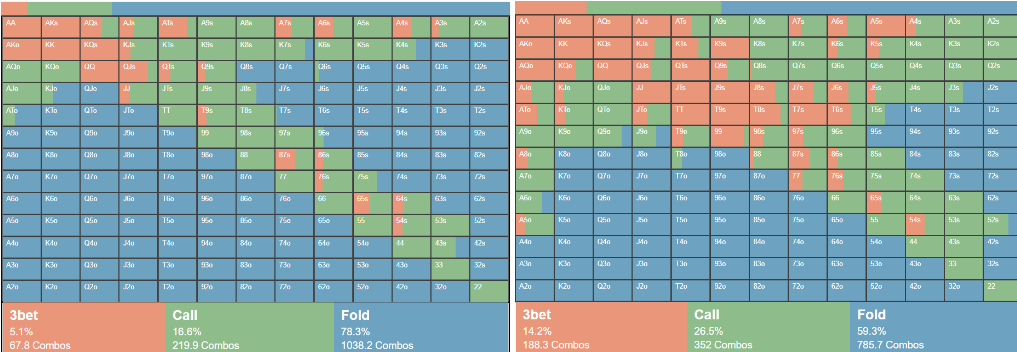
The above charts represent how to properly defend the big blind against lojack and button raises. Notice that while there are some three-betting bluffing hands, they are hands that flop well against the pre-flop raiser’s range. If your opponents are playing with reasonable ranges in a cash game, you must play tighter and more aggressively from the big blind. Maintain a tighter and more aggressive strategy from these spots, but be sure to exploit any errors you notice from your opponents. Usually you will want to use a linear range, but if you know an opponent will fold any bet to a raise from late position, exploit that mistake.
Don’t Overplay Marginal Hands Post Flop
Online Cash Game Hand Example
You are playing in a .50/$1 cash game online with $100 in your stack. It folds around to you in the cutoff, and you have A♠A♥. You raise $2.50, and only the big blind calls.
The flop comes 6♦-5♣-3♣, after the big blind checks you bet $4 and are check-raised to $14. While you shouldn’t fold just yet, especially in a small stakes game warning alarms should be going off in your head. Some opponents will find bluffs with gutshot straight draws or flush draws, but at the small stakes opponents rarely bluff. Even with aces, this is a flop you can check back at some percentage, as it does not connect with your range but connects with the big blind’s.
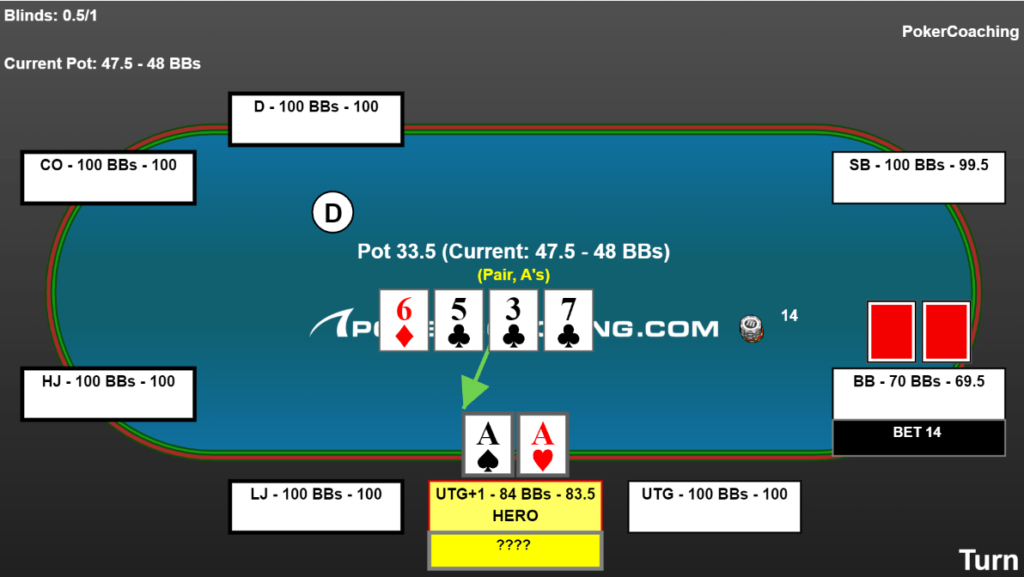
You call the flop bet, after the 7♣ on the turn your opponent leads out for $13. It may feel painful, but on the turn you should fold your pocket aces. There are a plethora of hands in your opponent’s range that dominate your aces. Your opponent could have a set, a straight, or even a flush after the third club arrives on the turn. A lot of novice poker players make the mistake of calling down with all of their premium pairs, wasting money by not recognizing when these pairs go from premium to marginal.
Bet Thinly For Value And Over-Fold Against Raises
Even at the mid-stakes, you will still play against poker players who struggle to raise enough on the river, especially as a bluff. To target overly cautious opponents, you should bet thinly on the river for value, and fold when you happen to get raised.
Online Cash Game Hand Example
You are playing in a .05/$1 online cash game with a stack of $100. After UTG folds, you raise $2.50 holding A♠J♠. Only the big blind calls.
The flop is J♣-8♦-6♠ and the big blind checks. In this spot, you should be betting the flop with your best made hands. Top pair-top kicker certainly qualifies as a best made hand, so you bet $3.50 and get called.
The turn is the K♥ and your opponent checks. You are likely still ahead, and can bet small or check depending on your read of your opponent.
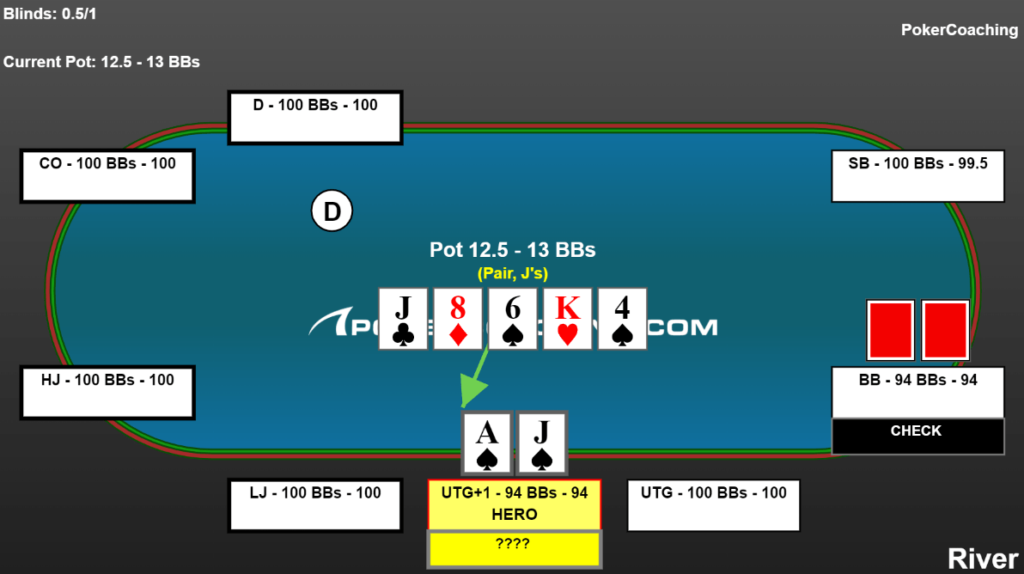
After your opponent checks following the 4♠ on the river, it is safe to assume you have the best hand. If your opponent had made any kind of hand, they would have bet on the turn or river, by checking they have given you the green light to bet small for thin value. You bet $7.50, and draw a call from J♦7♦. Recognizing a good spot to go for thin value resulted in squeezing a bit more equity out of your opponent.
Three Bluffing Spots For Online Poker Games
Weak, tight poker players do not win in poker anymore. If you want to be a big winner, you have to steal pots that don’t belong to you! Poker players who take the time to study bluff spots can give themselves a big edge in online games.
#1 – Turning A Pair Into A Bluff
Bluffing with your paired hands can help you be more formidable at the poker table. Too many players auto-pilot and over-value showdown value when they have a pair. Some of your pairs will block strong hands out of your opponent’s range, making them qualify bluffing candidates. Especially if they have weak showdown value, paired-blocking hands play far better as a bluff.
Online Poker Tournament Hand Example
You are UTG+1 with 40,000 and the blinds at 500/1,000. You raise 2,100 with 9♠8♠ and only the big blind calls.
The flop comes A♣-K♥-2♠, even though your hand doesn’t connect well with the board, it does connect well with your range incentivizing you to continuation bet. Your opponent checks and calls your 1,200 continuation bet.
The turn is the 8♦, while it may be tempting to check it down to showdown, you just picked up some equity, and your range still connects better with this board than your opponent’s. Betting big on the turn puts your opponent in a tough spot, even if they have you beat with a better pair, you still have better pairs in your range and could bluff them on the river. Additionally, you could hit a third eight and target pairs for some additional value.

Your opponent checks the turn, you bet 9,500 and they call. The river is the 4♠, a complete brick. Your opponent checks to you again, and although you may want to check to see a safe showdown, you should blast it. Even though you only have a paired eight, you still have the overwhelming range advantage and have been representing the nuts with your bets. With the SPR and your range, it is better to attempt to steal the massive pot than see if your eights are good at showdown.
#2 – Using Low Equity Bluffs
Some bluffing spots are easier to recognize than others. Most poker players who study on a regular basis know that turn spots with draws are often equitable spots to bluff. While you should bluff with draws on the turn, if that is the only time you are bluffing you are not bluffing nearly enough.
A proper bluffing frequency must include low equity bluffs. Although low equity bluff spots can be difficult to recognize, being able to implement them will reward you with more stolen pots.
Online Poker Tournament Hand Example
You are on the button with a stack of 205,000 chips and the blinds at 2,500/5,000. It folds around to you and you raise 11,000 holding K♠2♠, only the big blinds calls.
The flop comes J♠-9♦-5♣, the big blind checks and you bet 21,500. Even though you have low equity on this board, GTO wants you to bet big with suited K-X combos. The big blind calls your bet.
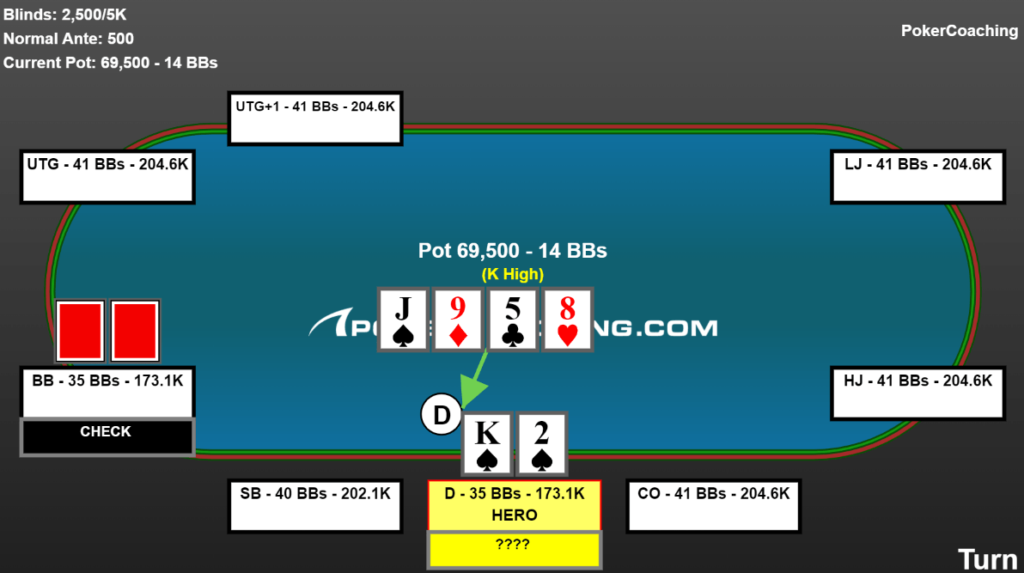
The turn is the 8♥ and the big blind checks. While there are times you want to block certain cards in your opponent’s range, it is also critical to recognize when you un-block cards in their folding range. All of the junky gutshot straight draw hands your opponent may have are unblocked by K♠2♠, if they are capable of folding such a hand it is worth firing another big bet to induce a fold. Even though you only have king-high, executing another pot-sized bluff bet is the best play.
#3 – Small Bluffs Out Of Position On The River Are Very Effective
Don’t Only Use Big Bet Sizes
Not many poker players think to make small river bets on the river, but when done correctly these bets can be a valuable way to bluff. To properly use small river bets as bluffs, you must have a balanced range with value bets to be effective. Balancing allows you to bluff with small bets, especially against opponents capable of making exploitative folds.
Online Poker Tournament Hand Example
You are on the big blind with 200,000 in chips and the blinds at 2,500/5,000. It folds to you following an 11,000 raise from the button. You make the call with K♥8♥.
The flop comes J♣-T♣-9♥, you check and the button bets 20,000. Although you could mix in some check-raises, you would rather do so with K-8 of clubs. You make the call.
The turn card is the 4♠ and it goes check-check.
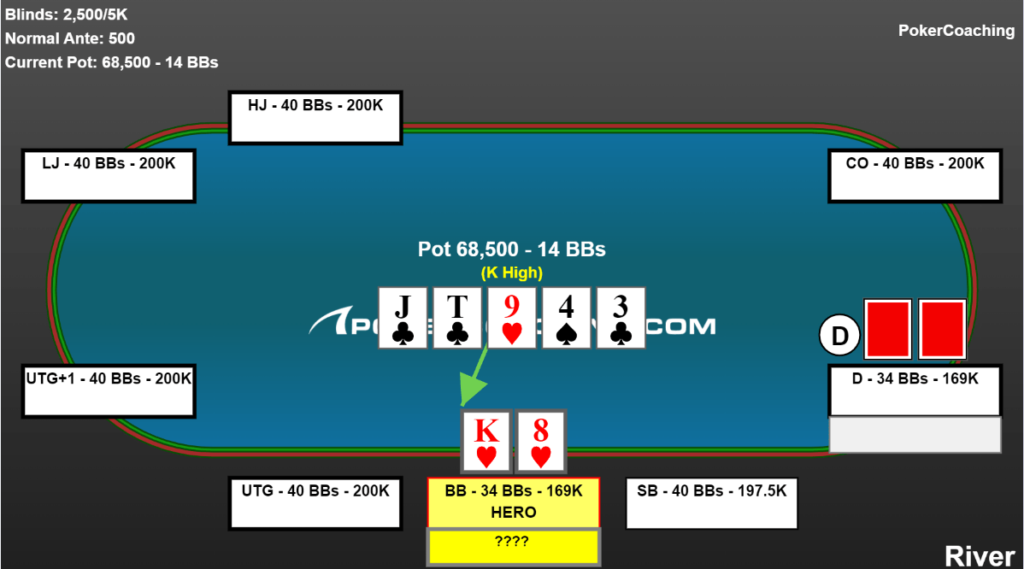
The river is the 3♣, you are at the end of the hand and only have king-high, should you go for the bluff here? First: You should consider what hands you block. Having K-X blocks a lot of paired hands that could bet small for value. If you can represent a paired jack or ten, there are plenty of hands in your opponent’s range that could fold to a small bet. Lacking any showdown value, if there is a chance a small bet can induce a fold make the bet. Especially at the small stakes, if you can cap your opponent’s range within hands that can find a fold, make small bets to steal pots on the river.
Tips For Off The Felt (Or Away From The Screen)
Study Poker Constantly And Improve Daily
Perhaps the most important thing you can do to be a successful online poker player is to study. Studying on a regular basis naturally gives you an edge over the majority of the player population that does not study.
The best way to study is by reviewing past hands you have played, and the vast majority of online poker sites keep a database of all of your hands. Study these hands on your own time, but also be sure to discuss your hands with other poker players. One of the best things you can do as a poker player is find players that are better than you and discuss the game with them. Resources like the PokerCoaching.com Discord channel are a great way of meeting other poker players that can help you step up your game, don’t be afraid to submit hands, ask questions, and see what your poker peers have to say.
Whether studying on your own or with friends, taking notes not only keeps a record of what has been studied but also helps you retain information better. Keep a notebook handy whenever you plan on studying poker, the act of intaking information and physically writing it out can help you better remember what to do when you are playing on the physical or virtual felt.
Exploit Exploit Exploit!
As live-streamed cash games become more and more popular, you may very well see some of your regular opponents participating if you play in a large, popular poker room. If you are facing players who have appeared on live streams, you have a great sample size of hands you can study to exploit them on the felt. Take notes and figure out what your opponents do incorrectly, take all of the free information at your disposal and use it to your advantage.
Bankroll Management For Online Poker Tournaments And Cash Games
A lot of people who attempt to play poker in a casino for the first time think they are going to come in and immediately win money, and while occasionally that happens, most beginners start out as losers. Poker is a bad way to get rich quick, but it is a great way to get rich slowly if you are patient and apply yourself.
A major part of being patient is playing within your bankroll and playing in games you can beat. Play with money you can afford to lose, and most importantly play in games you can beat. The higher the stakes, the better the opponents, making you much more profitable when playing at the right skill level.
The key to being a profitable poker player is finding a game you can beat and playing it in as much volume as possible. If you can do that, you will grow your bankroll exponentially in the long run.
Conclusion
For poker players willing to put the time in to study and apply themselves, online poker provides a great opportunity for tournament and cash game players to improve quickly while growing their bankroll. When playing poker online, you have the ability to multi-table, drastically increasing your hands played per hour and the rate of experience you gain. Online poker provides not just the ability to play poker conveniently, but it also provides a resource to become better. Take the advice and tips I have outlined in this article, and soon you will be making a name for yourself on the virtual felt.



